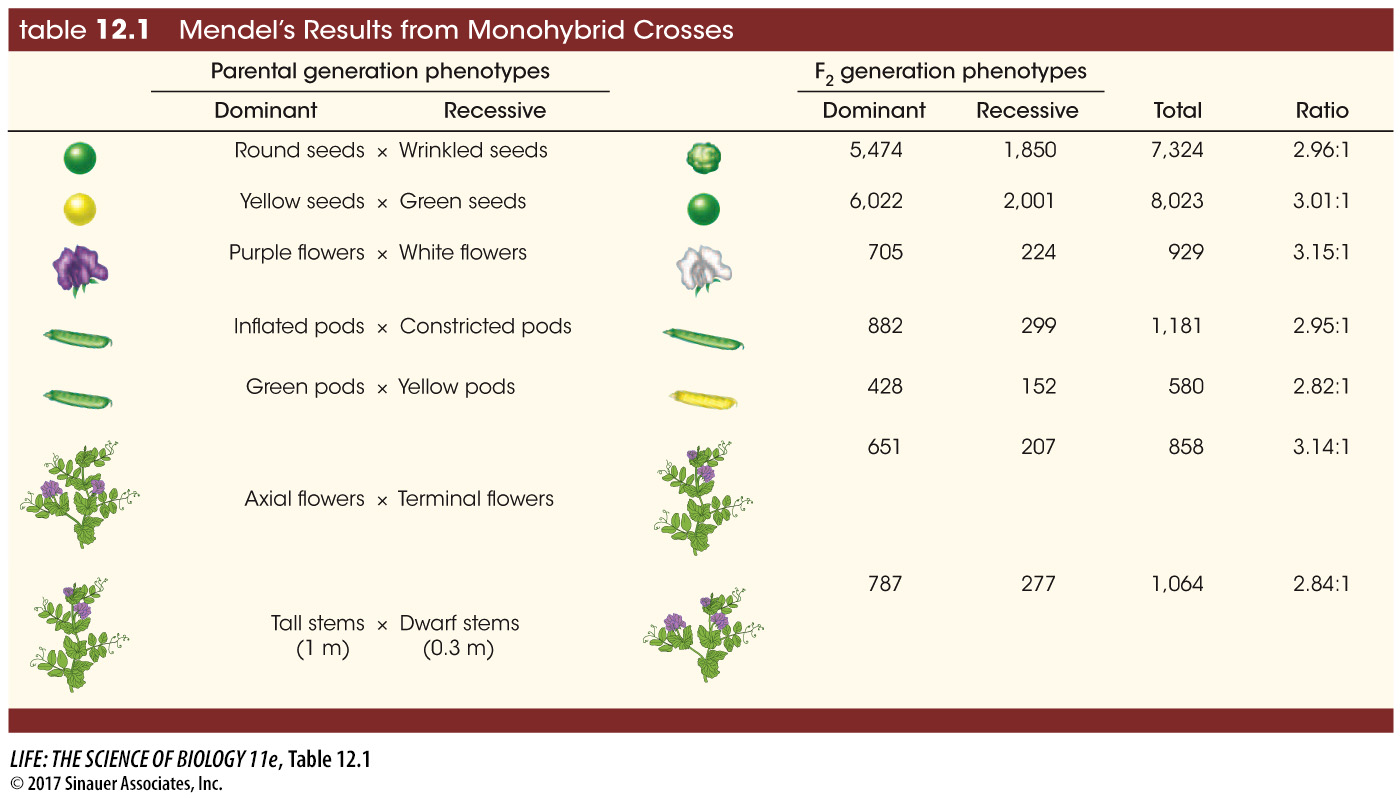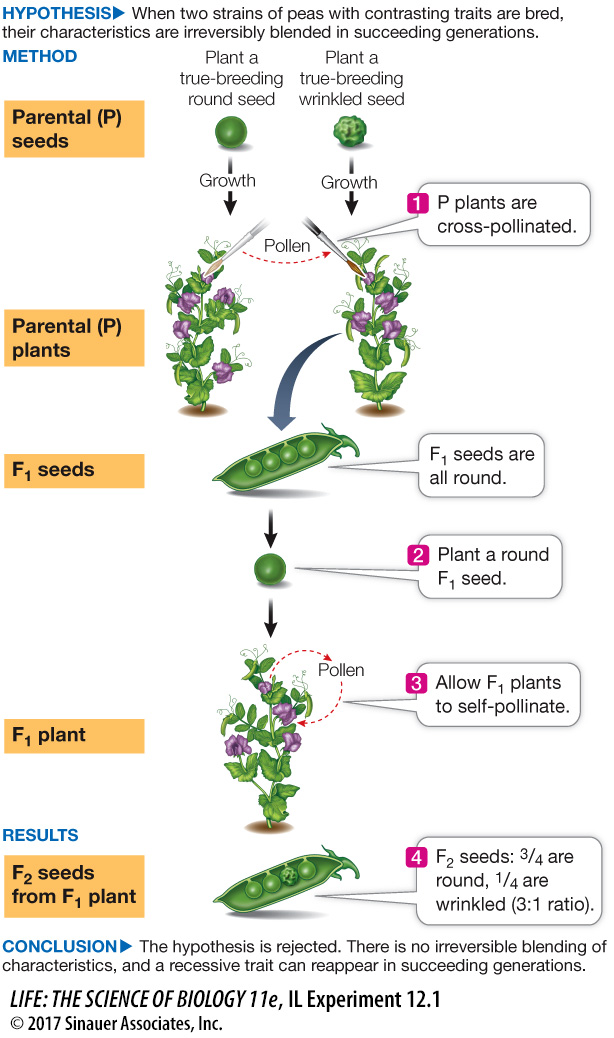Mendel’s first experiments involved monohybrid crosses
The term “hybrid” refers to the offspring of crosses between organisms differing in one or more characters. In Mendel’s first experiments, he crossed parental (P) varieties with contrasting traits for a single character, producing monohybrids (from the Greek monos, “single”) in the F1 generation. He subsequently planted the F1 seeds and allowed the resulting plants to self-
Mendel performed the same experiment for seven pea characters. You can follow his method in Investigating Life: Mendel's Monohybrid Cross, using seed shape as an example. When he crossed a variety that made round seeds with one that made wrinkled seeds, all of the F1 seeds were round—
The F1 offspring were not a blend of the two traits of the parents. Only one of the traits was present (in this case, round seeds).
Some F2 offspring had wrinkled seeds. The trait had not disappeared because of blending.
These observations led to a rejection of the blending theory of inheritance and provided support for the particulate theory. We now know that hereditary determinants are not actually “particulate,” but they are physically distinct entities: sequences of DNA carried on chromosomes, which we now call genes.
All seven crosses between varieties with contrasting traits gave the same kind of data (Table 12.1). In the F1 generation only one of the two traits was seen, but the other trait reappeared in about one-

You can see in Table 12.1 that for each character, Mendel counted hundreds or even thousands of F2 seeds or plants to see how many carried each trait. As we will discuss in more detail below, the probability of a plant inheriting a particular trait is independent of the probability of another plant inheriting the same trait. If Mendel had looked at only a few F2 progeny from the “round × wrinkled” cross, he might, by chance, have found only round seeds. Or he might have found a higher proportion of wrinkled seeds than he did. In order to discover recurring patterns and to develop his laws of inheritance, Mendel used very large numbers of plants.
Mendel went on to expand on the particulate theory. He proposed that hereditary determinants—
Mendel concluded that while each gamete contains one copy of each gene, the resulting zygote contains two copies, because it is produced by the fusion of two gametes. Furthermore, he surmised that different traits arise from different forms of a gene (now called alleles) for a particular character. For example, Mendel studied two alleles for seed shape: one that resulted in round seeds and the other resulting in wrinkled seeds.
investigating life
Mendel’s Monohybrid Experiments
experiment
Original Paper: The original German version of Mendel’s paper, Versuche uber Pflanzen-
Mendel performed crosses with pea plants and carefully analyzed the outcomes to show that genetic determinants are particulate.

work with the data

Mendel’s monohybrid crosses were key to his rejection of the theory of blending inheritance. While the experiment at left illustrates a monohybrid cross with round and wrinkled seeds, another of his monohybrid crosses was between true-
QUESTIONS
1.
Use the hypothesis that the ratio of yellow to green seeds in the F2 generation would be 3:1 and perform a chi-
2.
Now total the data from all the plants and rerun the chi-
| Seed color | ||
|---|---|---|
| Plant | Yellow | Green |
| 1 | 25 | 11 |
| 2 | 32 | 7 |
| 3 | 14 | 5 |
| 4 | 70 | 27 |
| 5 | 24 | 13 |
| 6 | 20 | 6 |
| 7 | 32 | 13 |
| 8 | 44 | 9 |
| 9 | 50 | 14 |
| 10 | 44 | 18 |
A similar work with the data exercise may be assigned in LaunchPad.
An organism that is homozygous for a gene has two alleles that are the same (for example, two copies of the allele for round seeds).
- Page 244
An organism that is heterozygous for a gene has two different alleles (for example, one allele for round seeds and one allele for wrinkled seeds).
In a heterozygote, one of the two alleles may be dominant (such as round, R) and the other recessive (wrinkled, r). By convention, dominant alleles are designated with uppercase letters and recessive alleles with lowercase letters. Note that the terms dominant and recessive refer only to which phenotype is expressed when the two allele are present together. They do not refer to which alleles are stronger, better, or more common.
The physical appearance of an organism is its phenotype. Mendel proposed that the phenotype is the result of the genotype, or genetic constitution, of the organism showing the phenotype. Round seeds and wrinkled seeds are two phenotypes resulting from three possible genotypes: the wrinkled seed phenotype is produced by the genotype rr, whereas the round seed phenotype is produced by either of the genotypes RR or Rr (because the R allele determines a dominant trait and the r allele determines a recessive trait).